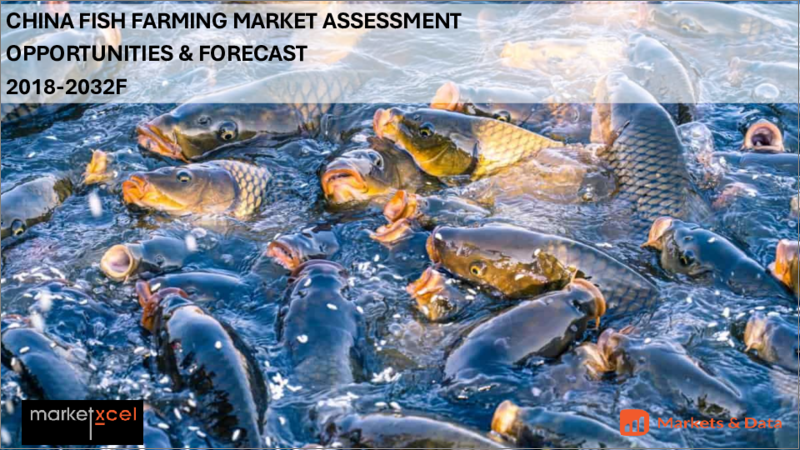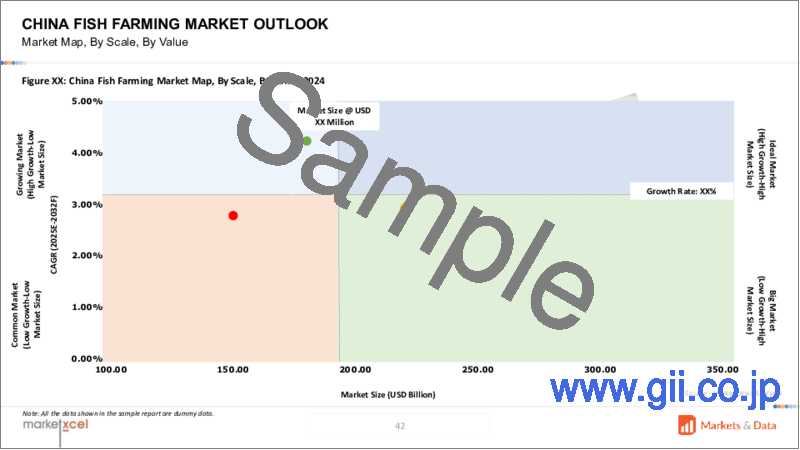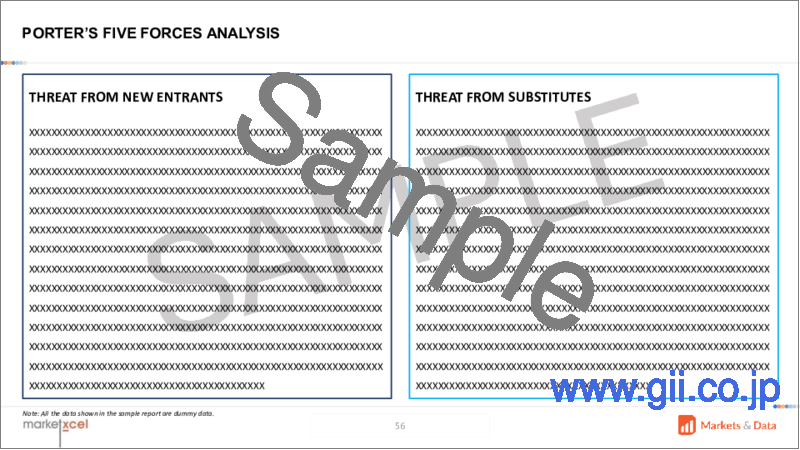|
|
市場調査レポート
商品コード
1549424
魚類養殖の中国市場の評価:種別、規模別、水源別、目的別、エンドユーザー別、流通チャネル別、地域別、機会、予測(2017年~2031年)China Fish Farming Market Assessment, By Species, By Scale, By Water Source, By Purpose, By End-user, By Distribution Channel, By Region, Opportunities and Forecast, 2017-2031F |
||||||
カスタマイズ可能
|
|||||||
| 魚類養殖の中国市場の評価:種別、規模別、水源別、目的別、エンドユーザー別、流通チャネル別、地域別、機会、予測(2017年~2031年) |
|
出版日: 2024年09月06日
発行: Markets & Data
ページ情報: 英文 126 Pages
納期: 3~5営業日
|
全表示
- 概要
- 図表
- 目次
中国の魚類養殖の市場規模は、2023年の371億6,000万米ドルから2031年に574億6,000万米ドルに達すると予測され、予測期間の2024年~2031年にCAGRで5.60%の成長が見込まれます。中国は世界的に水産物の主要輸出国であるため、中国の魚類養殖市場は成長を示しています。米国、欧州諸国、日本などの国際マーケットプレイスが、中国の魚類養殖の需要に大きな影響を与えています。
安価な労働力が利用可能で、エネルギーコストや輸送コストが低いことも、中国の魚類養殖需要に影響を与える要因の1つです。さらに、環境と持続可能な魚類養殖に対する意識の高まりが、持続可能な養殖魚の需要の増加につながっています。
ハクレン、ソウギョ、コイなどの種は、異なる環境への適応性と効率的な飼料転換率のため、中国の養殖でもっとも一般的な魚種です。
米国の農務省が2024年3月に発表したレポートによると、中国は2023年に世界最大の水産物生産国となり、正式な生産高は7,100万トンと推定されています。生産高は2022年から3.5%増加しました。さらに、サケやロブスターを含む高価値製品への需要は、国内では依然として旺盛です。
水生動物に対する需要の増加に対応するため、中国では魚類養殖が増加しています。魚類養殖は、高いレベルの生産高に向け制御された環境を提供し、効果的な方法で市場の需要を満たすことができます。再循環水産養殖システム(RAS)や総合多栄養水産養殖(IMTA)といった養殖の技術的進歩により、中国の生産者は持続可能な生産の増加と環境問題の軽減を達成できるようになっています。この産業の規模と成長スピードは、持続可能な食料生産手段として養殖を奨励する政府の政策によって支えられてきました。とはいえ、養殖システムのもっとも一般的な方法は、特にコイやティラピアなどの種を対象としたものです。
市場成長を促進する生産システムへの投資
中国の魚類養殖産業は、水槽養殖、再循環水産養殖システム(RAS)、池養殖、ケージ養殖、総合多栄養水産養殖(IMTA)などのさまざまな魚類養殖生産システムに大規模な投資を行っており、これが市場の成長を後押ししています。相対的な利用可能性と技術の進歩は、依然として養殖システムの近代化の促進要因となっています。モニタリングと制御システムの高度化により、生産者は水質、給餌レジーム、魚の全体的な健康を最適化することができます。こうした技術革新の多くは、中国の生産者にとってRAS、水槽養殖、IMTAをより実現可能で魅力的な選択肢にしてきました。そのほかにも、特定の疾患に対する耐性のある魚種や飼料の配合強化が、持続可能で効率的なこれらのシステムを支えるバイオテクノロジーの発展です。
2024年3月、国有企業であるChina International Marine Containers Groupは、広東省でティラピア種を養殖するための再循環水産養殖システム(RAS)プロジェクトに1,400万米ドルを投資することを発表しました。この投資に続き、同社はオフショア水産養殖システムの開発とコンテナ技術の拡大に乗り出しました。
市場成長を促進する魚消費
中国の魚消費の増加は、複数の社会経済的要因に後押しされ、魚類養殖の著しい成長を引き起こしています。人口の多さ、所得の増加、都市化によって、食生活の選好はより健康的でタンパク質の豊富な食品へと変化しており、魚はその重要な供給源の1つとなっています。一般に、魚はオメガ3脂肪酸、ビタミン、ミネラルを豊富に含む健康的な栄養源とみなされ、認識されています。そのため、健康を意識するかなりの数の消費者を惹きつけています。その上、中国政府は国家レベルの栄養ガイドラインを通じて魚の摂取を提唱しており、人々に奨励しています。
Food and Agriculture Organizationのデータによると、中国は年間5万7,474トンを消費する、世界最大の魚消費国です。天然魚の資源が乏しく、天然漁業に対する環境への懸念が高まっているため、魚類養殖は増大する需要を満たすための持続可能な代替手段を提供しています。水産養殖は、魚の繁殖、給餌、収穫を管理し、安定した供給と品質を保証します。加えて、技術の進歩や水産養殖方法の改善により、魚類養殖は効率的かつ経済的に実行可能なものとなり、生産コストが下がり、収益性も向上しました。
当レポートでは、中国の魚類養殖市場について調査分析し、市場規模と予測、市場力学、主要企業の情勢と見通しなどを提供しています。
目次
第1章 プロジェクトの範囲と定義
第2章 調査手法
第3章 エグゼクティブサマリー
第4章 顧客の声
- 人口統計(年齢/コホート分析 - ベビーブーマー世代、X世代、ミレニアル世代、Z世代、性別、所得 - 低所得、中所得、高所得、地域など)
- 市場の認知度と製品情報
- ブランド認知度とロイヤルティ
- 購入決定において考慮される要素
- 購入頻度
- 購入媒体
- ブランドアンバサダーやインフルエンサーマーケティングが製品/ブランドの浸透に果たす役割
第5章 中国の魚類養殖市場の見通し(2017年~2031年)
- 市場規模の分析と予測
- 金額
- 数量
- 市場シェア分析と予測
- 種別
- 規模別
- 水源別
- 目的別
- エンドユーザー別
- 流通チャネル別
- 地域別
- 市場シェア分析:企業別(金額)(上位5社とその他 - 2023年)
- 市場マップ分析(2023年)
- 種別
- 規模別
- 水源別
- 目的別
- エンドユーザー別
- 流通チャネル別
- 地域別
第6章 需給分析
第7章 輸入と輸出の分析
第8章 バリューチェーン分析
第9章 ポーターのファイブフォース分析
第10章 PESTLE分析
第11章 マクロ経済指標
第12章 価格分析
第13章 利益率分析
第14章 市場力学
- 市場促進要因
- 市場の課題
第15章 市場の動向と発展
第16章 ケーススタディ
第17章 競合情勢
- マーケットリーダー上位5社の競合マトリクス
- 上位5社のSWOT分析
- 主要企業上位10社の情勢
- Zoneco Group Co., LTD
- Hainan Xiangtai Fishery Co., LTD
- Nordic Aqua Partners
- Zhanjiang Guolian Aquatic Products Co., Ltd.
- Shandong Oriental Ocean Sci-Tech Co., Ltd.
- DAHU AQUACULTURE CO., LTD.
- Shandong Homey Aquatic Development Co., Ltd.
- Sino Agro Foods
- China National Fisheries Corporation
- Hendrix Genetics BV
第18章 戦略的推奨
第19章 当社について、免責事項
List of Tables
- Table 1. Pricing Analysis of Products from Key Players
- Table 2. Competition Matrix of Top 5 Market Leaders
- Table 3. Mergers & Acquisitions/ Joint Ventures (If Applicable)
- Table 4. About Us - Regions and Countries Where We Have Executed Client Projects
List of Figures
- Figure 1. China Fish Farming Market, By Value, In USD Billion, 2017-2031F
- Figure 2. China Fish Farming Market, By Volume, In Million Tons, 2017-2031F
- Figure 3. China Fish Farming Market Share (%), By Species, 2017-2031F
- Figure 4. China Fish Farming Market Share (%), By Scale, 2017-2031F
- Figure 5. China Fish Farming Market Share (%), By Water Source, 2017-2031F
- Figure 6. China Fish Farming Market Share (%), By Purpose, 2017-2031F
- Figure 7. China Fish Farming Market Share (%), By End-user, 2017-2031F
- Figure 8. China Fish Farming Market Share (%), By Distribution Channel, 2017-2031F
- Figure 9. China Fish Farming Market Share (%), By Region, 2017-2031F
- Figure 10. By Species Map-Market Size (USD Billion) & Growth Rate (%), 2023
- Figure 11. By Scale Map-Market Size (USD Billion) & Growth Rate (%), 2023
- Figure 12. By Water Source Map-Market Size (USD Billion) & Growth Rate (%), 2023
- Figure 13. By Purpose Size Map-Market Size (USD Billion) & Growth Rate (%), 2023
- Figure 14. By End-user Map-Market Size (USD Billion) & Growth Rate (%), 2023
- Figure 15. By Distribution Channel Map-Market Size (USD Billion) & Growth Rate (%), 2023
- Figure 16. By Region Map-Market Size (USD Billion) & Growth Rate (%), 2023
China fish farming market is projected to witness a CAGR of 5.60% during the forecast period 2024-2031, growing from USD 37.16 billion in 2023 to USD 57.46 billion in 2031. The market of fish farming in China is witnessing growth as the country is the major exporter of fish and seafood globally. International marketplaces such as the United States, European countries, and Japan significantly impacting the demand for the fish farming in the country.
The availability of cheap labor and prevalence of lower energy and transportation costs are some other factors which influence the demand for fish farming in China. Moreover, the increasing awareness of the environmental and sustainable fish farming is leading to the increased demand for sustainably farmed fish.
Species such as silver carp, grass carp, and common carp are the most common species in the Chinese aquaculture due to their adaptability to different environments and efficient feed conversion rates.
As per the report published by the United States Department of Agriculture in March 2024, it has been found that China was the largest producer of seafood in the world in 2023, with the official production estimated at 71 million metric tons. The production was up by 3.5% from 2022.Moreover, demand for high-value products, including salmon and lobster remains strong in the country.
There has been an increase in fish farming in China to accommodate the increasing demand for aquatic animals. Fish farming can provide a controlled environment for a high level of production output and fulfill market demand in an effective manner. Technological advances within aquaculture, such as recirculating aquaculture systems (RAS) and integrated multi-trophic aquaculture (IMTA), have ensured Chinese producers that can achieve increased sustainable production and reduced environmental concerns. This scale and speed of industry growth has been supported by government policies that encourage aquaculture as a sustainable means of food production. Although, the most common methods of aquaculture systems are particularly for species such as carp and tilapia.
Investment in the Production Systems to Foster Market Growth
The fish farming industry of China has been significantly investing in various fish farming production systems such as tank farming, recirculating aquaculture systems (RAS), pond farming, cage farming, and integrated multi-trophic aquaculture (IMTA) which is boosting market growth. The relative availability and the advancements taking place in technology remain driving factors for the modernization of aquaculture systems. Sophistication in monitoring and control systems allows the producer to optimize water quality, feeding regimes, and overall health of fish. Many of these technological innovations have been making RAS, tank farming, and IMTA more feasible and attractive options for Chinese producers. Besides that, resistant fish strains for some particular diseases and enhanced feed formulation are the other biotechnological developments supporting these systems for sustainability and efficiency.
In March 2024, State-owned China International Marine Containers Group notified about its investment of USD 14 million in a recirculating aquaculture system (RAS) project to farm tilapia species in the province of Guangdong. The investment has been followed by the company's move to dive into the offshore aquaculture system development and the expansion of its container technology.
Fish Consumption to Propel Market Growth
Increasing fish consumption in China has triggered remarkable growth of fish farming, spurred by several socio-economic factors. Large population, rising income, and urbanization have been shifting dietary preferences to healthier and protein-rich food, in which fish is amongst the vital sources. In general, fish is seen and perceived as a healthy source of nutrition, rich in omega-3 fatty acids, vitamins, and minerals. Thus, it attracts a considerable number of consumers who are conscious about their health. Besides, Chinese government has advocated fish consumption through nutritional guidelines at the national level, serving as an added encouragement for people.
According to the data of Food and Agriculture Organization, China is globally the largest consumer of fish with the consumption of 57,474 tons annually. Due to the natural fish stock and growing environmental concern for wild fishing, fish farming offers a sustainable alternative to meet the increasing demand. Aquaculture provides controlled breeding, feeding, and harvesting of fish to ensure consistent supply and quality. In addition, due to technological advancement and better aquaculture practices, fish farming became efficient and more economically viable with lower production cost and increased profitability.
Besides, such development has been in line with the strategic priorities of China to attain food security and ensure rural economic development. In this respect, China promotes its domestic aquaculture to decrease its dependence on imported fish and strengthen the corresponding local industries, thus creating new jobs and securing rural development. In this way, increase in fish consumption in China becomes the significant push factor for the current unprecedented growth of fish farming in this country.
Fish Production to Drive Market Growth
The increasing fish production in China is driving a corresponding rise in demand for fish farming due to several interrelated factors. As the world's largest consumer of fish, China's growing population and rising income levels have fueled a higher demand for fish and seafood products. This surge in domestic consumption necessitates increased fish production to meet dietary preferences that favor fish as a staple source of protein.
The shift towards aquaculture as a sustainable alternative to wild-caught fisheries is another crucial factor. Overfishing and declining wild fish stocks have prompted China to invest heavily in aquaculture to ensure a stable and reliable supply of fish, reducing pressure on natural marine resources. Aquaculture provides the ability to control and enhance fish production efficiency, quality, and consistency, making it a more viable option to meet growing demand.
Moreover, technological advancements in fish farming, such as improved breeding techniques and the adoption of recirculating aquaculture systems, have increased production capacities and reduced environmental impacts. This combined with government support and favorable policies, has made fish farming an attractive and necessary means to meet both domestic consumption needs and export opportunities. Thus, the increasing fish production in China is inextricably linked to the rising demand for efficient and sustainable fish farming practices.
According to the 2024 China Fishery Products Report by United States Department of Agriculture, fish remains to be the predominant farmed product which constituted 52.2% of the aquaculture production in 2022 in China. Moreover, the total fish production in 22 rose 2.8% year-on-year to a production of 29 million metric tons.
Future Market Scenario (2024 - 2031F)
The market is expected to witness expansion in the fish farming production methods which are environmentally sustainable and are more convenient than the traditional farming methods. The increase in awareness of environmental sustainability has been one of the principal drivers for adopting advanced aquaculture systems in China. Traditional intensive fish farming practices, especially open-net pen systems, have been associated with serious environmental concerns regarding water pollution and habitat destruction, with the spread of diseases to wild populations of fish. Thus, modern techniques such as RAS, tank farming, and IMTA, which come with better water quality control, less use of antibiotics and chemicals, and minimal impact on the surrounding ecosystems, are soon gaining popularity in the market. Particularly, IMTA is an environmentally sustainable production technique since it combines species that utilize wastes, hence balancing and maintaining efficiency in the ecosystem.
Key Players Landscape and Outlook
The key players are facilitating expansion in the market with the help of strategic partnerships and introduction of innovative products. The key players are striving to enter into the newer markets and regions to gain a competitive edge.
The key players are seeking the help of mergers and acquisitions to expand themselves in market and gain a competitive edge. This is further driving the growth of the fish farming market of China.
In 2023, China National Fisheries Corporation has acquired three aqua culture companies. These are China National Agricultural Development Group Zhoushan Overseas Fisheries, Zhongyu Global Seafood Corporation, and China Aquatic Products Zhoushan Marine Fisheries Products. China National Fisheries Corporation made this acquisition with the value of USD 237.8 million. This acquisition will help the company to achieve integrated management of its entire offshore fishery industry chain.
Table of Contents
1. Project Scope and Definitions
2. Research Methodology
3. Executive Summary
4. Voice of Customer
- 4.1. Demographics (Age/Cohort Analysis - Baby Boomers and Gen X, Millennials, Gen Z; Gender; Income - Low, Mid and High; Geography; etc.)
- 4.2. Market Awareness and Product Information
- 4.3. Brand Awareness and Loyalty
- 4.4. Factors Considered in Purchase Decisions
- 4.4.1. Quality
- 4.4.2. Ease in Availability
- 4.4.3. Price
- 4.4.4. Peer Group Influence
- 4.5. Frequency of Purchase
- 4.6. Medium of Purchase
- 4.7. Role of Brand Ambassador or Influencer Marketing on Product/Brand Absorption
5. China Fish Farming Market Outlook, 2017-2031F
- 5.1. Market Size Analysis & Forecast
- 5.1.1. By Value
- 5.1.2. By Volume
- 5.2. Market Share Analysis & Forecast
- 5.2.1. By Species
- 5.2.1.1. Freshwater Fish Farming
- 5.2.1.1.1. Grass carp
- 5.2.1.1.2. Silver carp
- 5.2.1.1.3. Bighead carp
- 5.2.1.1.4. Blunt snout bream
- 5.2.1.1.5. Others
- 5.2.1.2. Saltwater Fish Farming
- 5.2.1.2.1. Salmon
- 5.2.1.2.2. Shrimp
- 5.2.1.2.3. Others
- 5.2.1.3. Brackish Water Fish Farming
- 5.2.1.3.1. Bahaba
- 5.2.1.3.2. Milkfish
- 5.2.1.3.3. Others
- 5.2.1.1. Freshwater Fish Farming
- 5.2.2. By Scale
- 5.2.2.1. Small Scale Fish Farming
- 5.2.2.2. Medium Scale Fish Farming
- 5.2.2.3. Large Scale Fish Farming
- 5.2.3. By Water Source
- 5.2.3.1. Freshwater
- 5.2.3.1.1. Rivers
- 5.2.3.1.2. Lakes
- 5.2.3.1.3. Reservoirs
- 5.2.3.2. Saltwater
- 5.2.3.2.1. Oceans
- 5.2.3.2.2. Seas
- 5.2.3.3. Brackish Water
- 5.2.3.3.1. Mangroves
- 5.2.3.3.2. Estuaries
- 5.2.3.1. Freshwater
- 5.2.4. By Purpose
- 5.2.4.1. Food Fish Farming
- 5.2.4.2. Ornamental Fish Farming
- 5.2.4.3. Others
- 5.2.5. By End-user
- 5.2.5.1. Residential
- 5.2.5.2. Commercial
- 5.2.6. By Distribution Channel
- 5.2.6.1. Offline
- 5.2.6.1.1. Direct B2B Sales
- 5.2.6.1.2. Supermarkets and Hypermarkets
- 5.2.6.1.3. Specialty Stores
- 5.2.6.1.4. Others
- 5.2.6.2. Online
- 5.2.6.2.1. E-commerce Websites
- 5.2.6.2.2. Company Owned Websites
- 5.2.6.1. Offline
- 5.2.7. By Region
- 5.2.7.1. South
- 5.2.7.2. East
- 5.2.7.3. North
- 5.2.7.4. Northeast
- 5.2.7.5. Central
- 5.2.7.6. Southwest
- 5.2.7.7. Northwest
- 5.2.8. By Company Market Share Analysis (Top 5 Companies and Others - By Value, 2023)
- 5.2.1. By Species
- 5.3. Market Map Analysis, 2023
- 5.3.1. By Species
- 5.3.2. By Scale
- 5.3.3. By Water Source
- 5.3.4. By Purpose
- 5.3.5. By End-user
- 5.3.6. By Distribution Channel
- 5.3.7. By Region
All segments will be provided for all regions covered
6. Demand Supply Analysis
7. Import and Export Analysis
8. Value Chain Analysis
9. Porter's Five Forces Analysis
10. PESTLE Analysis
11. Macro-economic Indicators
12. Pricing Analysis
13. Profit Margin Analysis
14. Market Dynamics
- 14.1. Market Drivers
- 14.2. Market Challenges
15. Market Trends and Developments
16. Case Studies
17. Competitive Landscape
- 17.1. Competition Matrix of Top 5 Market Leaders
- 17.2. SWOT Analysis for Top 5 Players
- 17.3. Key Players Landscape for Top 10 Market Players
- 17.3.1. Zoneco Group Co.,LTD
- 17.3.1.1. Company Details
- 17.3.1.2. Key Management Personnel
- 17.3.1.3. Products and Services
- 17.3.1.4. Financials (As Reported)
- 17.3.1.5. Key Market Focus and Geographical Presence
- 17.3.1.6. Recent Developments/Collaborations/Partnerships/Mergers and Acquisition
- 17.3.2. Hainan Xiangtai Fishery Co.,LTD
- 17.3.3. Nordic Aqua Partners
- 17.3.4. Zhanjiang Guolian Aquatic Products Co., Ltd.
- 17.3.5. Shandong Oriental Ocean Sci-Tech Co., Ltd.
- 17.3.6. DAHU AQUACULTURE CO.,LTD.
- 17.3.7. Shandong Homey Aquatic Development Co., Ltd.
- 17.3.8. Sino Agro Foods
- 17.3.9. China National Fisheries Corporation
- 17.3.10. Hendrix Genetics BV
- 17.3.1. Zoneco Group Co.,LTD
Companies mentioned above DO NOT hold any order as per market share and can be changed as per information available during research work.





